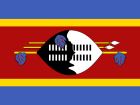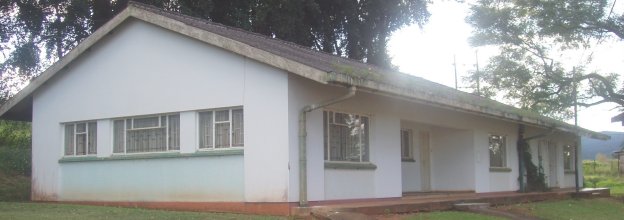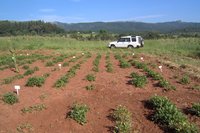
Eswatini National Plant Genetic Resources Centre

Background

Eswatini like most SADC countries possesses an enormous wealth of genetic resources of both cultivated and crops and wild plant species. In spite of this, they have been inevitably endangered, gradually eroded and as a result been threatened by extinction. This is more so due to the fact that their role in the life of mankind especially the Swazis society, is a recent realisation, if not all along been overlooked. It is for the same reason however that the country realised the need to set up a National Plant Genetic Resources Centre (NPGRC) in 1989. This unit was entrusted with the task of saving through collection and subsequent conservation of the countrys treasure that could still be on the loose from further extinction. The NPGRC operates under the umbrella of the Agricultural Research Division of the Ministry of Agriculture and Cooperatives (MOAC) based at the Malkerns Research Station.
Objectives
The objectives of the NPGRC encompasses the following:
- To collect and conserve the countrys plant genetic resources;
- To collect local land races around the country;
- To multiply and describe the characteristics of the collected material;
- Maintain the active collections and send duplicates to the base collection at the SPGRC;
- Document data on conserved material;
- Distribute and promote on-farm conservation of crop diversity through community seed banks;
- Raise awareness on the role and importance of plant genetic resources in ensuring food security in the SADC region;
- To promote conservation of PGR especially vegetative propagated material in field gene banks.
Currently Running Projects of Interest
The NPGRC was invited to participate in a Home Economics department of the Ministry of Agriculture and Cooperatives survey during the month of May 2004. The curator is also taking part in a Marula Project which is a brain child of Her Majesty the Queen Mother of the Kingdom of Eswatini, and run under MOAC aimed at commercialising marula (Sclerocarya caffra) production while also curbing the dangers that all other indigenous plants are exposed to during this era of agricultural development in particularly in the drought prone yet arable lowveld region of Eswatini.
More on update of the progress of the activities aimed towards achieving the objectives of the NPGRC and the SADC network will hopefully be realised.
Collections
Several collection missions have been conducted since 1993. A variety of local PGRs have been conserved and stored in the gene bank. However a lot of material is feared to be on the loose and threatened by extinction. Hence, more collection expeditions are still on the pipeline especially vegetatively propagated material, wild crop relatives, traditional leafy vegetables, leguminous crops as well as medicinal plants.
Multiplications
Seed multiplication is a continuous activity done to maintain adequate seed quantities in the gene bank as the samples obtained from rural dwellers most of which are old aged poor men and women, are usually very small. This is done immediately after each collection mission to meet reasonable quantities for conservation and duplication purposes.
Characterisation
Characterisation has now been done on maize, sorghum, cucurbits and groundnuts. However, this activity will continue until all collected material has been characterised as the characterisation data will be very useful to the end users such a breeders.
Documentation
Passport data, characters data, and active collection data entry has been done on the SDIS developed for the SADC network.
Distribution of material
Material has been distributed on request to researchers (pathologist, food science and technology, cereals agronomy sections of the Agricultural Research Division) as well as to farmers, schools, Uniswa and to Non-Governmental Organisations (NGOs). The demand from farmers is difficult to meet since farmers tend to request for seed samples every season claiming that they have lost their indigenous seed from grandparent and they cannot afford buying seeds. Hence a move aimed at establishing seed banks around the country is underway as pilot areas have been identified.
NPGRCom
The NPGR Committee membership now stands as follows:
Dr. I. S. Kunene - Chairperson (UNISWA, Biology)
Mr. S. Simelane - Alternate Chair (Seed Registrar - Agriculture)
Ms. Z. Mamba - Member (Agronomy, Agriculture)
Mr. G. M. Dlamini - Member (Taxonomy, Agriculture)
Dr. D. Earnshaw - Member (UNISWA, Crop Production)
Ms. L. Gumbi - Member (Swazi Environmental Authority)
Mr. D. Nhlabatsi - Member (ACAT Swaziland)
Mr. N. Mavuso - Member (Seed Technology)
Mr. V. B. Simelane - Member (Maize Breeding)
Mr. T. Gumedze - Secretary (Curator, NPGRC)
Staff
Mr T. Gumedze - Curator
Mr Musa M. Mbingo - Documentation Officer
Contacts
Malkerns Research Station, P O Box 4
MALKERNS, Swaziland
Tel: 268-52-83178, Fax: 268-52-83360/490
Email: This email address is being protected from spambots. You need JavaScript enabled to view it.; This email address is being protected from spambots. You need JavaScript enabled to view it. (Curator - Mr Thembinkosi Gumedze)
MALKERNS, Swaziland
Tel: 268-52-83178, Fax: 268-52-83360/490
Email: This email address is being protected from spambots. You need JavaScript enabled to view it.; This email address is being protected from spambots. You need JavaScript enabled to view it. (Curator - Mr Thembinkosi Gumedze)


